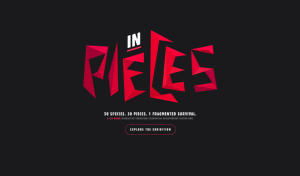Theme: National Endangered Species Day
Back to Top
|
 |
|
Great Big Story: On the Brink
|
Science |
|
As the title suggests, On the Brink (a series of short films) invites its audience to "get to know some of Earth's most incredible and threatened species - before it's too late." Each episode highlights a different creature, and though most episodes are just over a minute in length, they are packed with information (including each animal's unique attributes and threats). Video footage may make you smile (check out the clouded leopard cubs featured in "These Playful Leopard Cubs Are A Rare Sight In The Wild") and squirm (arachnophobes should avoid the red-kneed tarantula in "A Hairy Situation: This Tarantula Is No Pet"). Quick and quick-witted, the full 71 episodes take under two hours to binge. Along the way, you will discover snakes, sloths, seahorses, and superior strength. Which bird is strong enough to break a human arm with its talon? Watch and find out! On the Brink is one of many series produced by Great Big Story, an award-winning cinematic platform dedicated to telling global stories surrounding "travel, food, culture, and more," since it was founded in 2015. [EMB] |
|





|
|
 |
|
Animal Planet Endangered Species
|
Science |
|
Fewer than 7,000 snow leopards are alive today. The world has fewer than 2,000 Yangtze Finless Porpoises. Only 60 Javan Rhinos remain. These statistics from Animal Planet's Endangered Species section are jarring, but not without hope. For each of the more than 40 species listed, the site curates a How You Can Help section, inviting action in a variety of forms, from supporting conservation organizations to educating yourself on reducing threats and harm to species. The site also provides general education on endangered species. Clicking on an animal of interest from the list, readers will locate information such as the animal's scientific name and endangered status, as well as video footage and related news stories. Many of the profiles also link to additional endangered species lists, including the IUCN Red List of Threatened Species, where readers can learn even more about animals facing threats and how they can help. Launched in 1996, Animal Planet is a television network aptly named for its coverage of animals and wildlife. [EMB] |
|





|
|
 |
|
Species in Pieces
|
Science |
|
Equal parts hopeful and heartbreaking, Species in Pieces is an interactive exhibition that showcases some of the world's "most interesting but unfortunately endangered species." Launched with the goal of informing and inspiring action on genetic diversity, the resource uses creative CSS formatting to display 30 fragmented pieces that represent and come together to visually form 30 species, symbolic of a "common struggle for survival." Clicking the "All Pieces" button in the top left corner of the site leads visitors to a rotating ring of all 30 animals included in the exhibit. Visitors may self-select a species to investigate or click the "Select a piece randomly" button, which surprises users with an automated pick. For each creature exhibited, ranging from red pandas (number 21) to knysna seahorses (number 9), visitors will find background information on that animal's statistics, video footage, information on the unique threats it faces, and additional resources by clicking the "What's the Threat?" button on the right side of the site. Visitors can also choose to "cycle through" the complete list of 30 species using the middle button on the left side. Designer and coder Bryan James created the site in 2015. To learn more about James's inspiration and research, click the "Causes and Sources" link at the bottom of the webpage. [EMB] |
|





|
|
 |
|
World Wildlife Fund: Teaching Resources
|
Science |
|
Welcome to the World Wildlife Fund's Wild Classroom, where you will find a Lesson Library of toolkits and resources that bring conservation ideology and the natural world to your learning space (even if it is remote). Toolkits are curated by theme, such as a specific animal (e.g. elephant or dolphin) or more general topic (e.g. biodiversity or food waste). Kits include teaching guides and comprehensive activities that span multiple subject areas, from STEM to art. Readers should note they will need to create a free account to access many of the materials. Additionally, in response to school closures, the site launched a "day-by-day activity plan to help keep kids learning, thinking, and having fun," (and to provide a respite for caregivers, too). These Wild Classroom Daily Activity Plans (accessible by clicking the link in the Weekly Activities Plans to Do at Home box near the top of the page) include articles, activities, games, and videos designed for "higher elementary to middle school grade levels." The Conservation in the Classroom section of the Educational Resources page also highlights livestream events and related tools of interest to educators. Looking for more information about the World Wildlife Fund? The site in its entirety has a wealth of resources related to their mission to "develop and deliver innovative solutions that protect communities [and] wildlife." [EMB] |
|





|
|
 |
|
Projects for Wildlife Podcast
|
Science |
|
Do you have a wildlife conservation idea but feel unsure of how to turn it into a reality? Projects for Wildlife may provide the guidance you seek. Hosted by Alicia Amerson, a marine biologist, entrepreneur, and animal aficionado, the podcast takes listeners "around the world to talk with conservation project leaders," inviting audiences to learn about these projects and the processes that brought such projects into existence. With approximately 75 episodes released as of this write-up, the show has featured a variety of guests, including animal sanctuary executives and wildlife photographers. The show also includes some "solo episodes," where Amerson provides "seeds of advice to shape your experiences and values into a vision ... [to] help you realize your biggest environmental goals." Want a more immersive experience? The In the Field page features upcoming events and opportunities that may be of interest. Or, perhaps you have a "wildlife project story," of your own to share. Click on the Pitch a Story tab to make your case! Projects for Wildlife is available to stream at the link above and on most popular streaming platforms (Spotify, Apple Podcasts, and Google Play, to name a few). [EMB] |
|





|
|



















